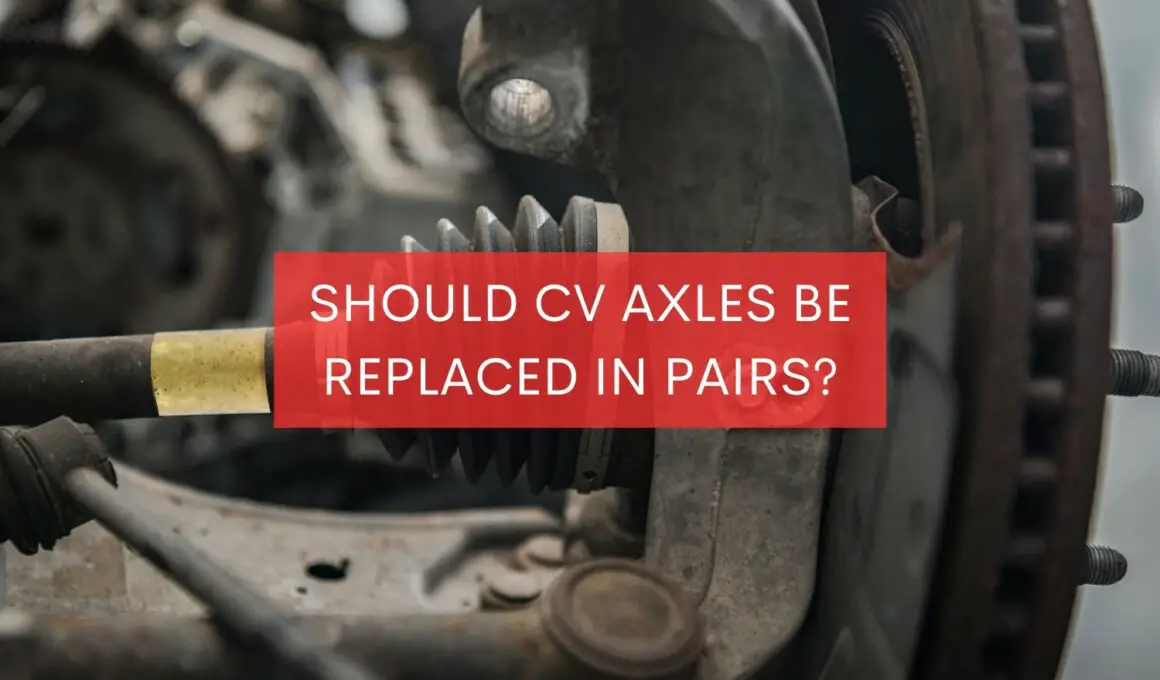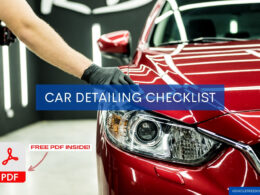In This Article Show
“Should CV axles be replaced in pairs?” This question isn’t as straightforward as it might seem, which is why I decided to dive into the topic and provide you with a comprehensive guide.
CV axles, or Constant Velocity axles, are crucial components of your vehicle’s drive train. They work tirelessly, enabling your car to move by transferring the torque from the transmission to the wheels, at a constant speed, while accommodating the up and down motion of the suspension. In layman’s terms, your car isn’t going anywhere without a properly functioning CV axle.
Neglecting your CV axles can lead to poor vehicle performance or complete drive failure. Despite their importance, many car owners aren’t fully aware of CV axles’ role in their vehicle’s overall health and how crucial their maintenance is.
In this post, we’ll delve into the mechanics of CV axles, signs of failure, and, most importantly, discuss the hot debate around whether CV axles should be replaced one at a time or in pairs.
Understanding CV Axles
Before we tackle the replacement question, it’s important to understand what CV axles are and how they function within your vehicle.
The CV axle, short for Constant Velocity axle, is a key part of your car’s drivetrain. It transfers power from your vehicle’s transmission and differential to the wheels. Essentially, it’s what makes your car move.
So, how does a CV axle work? Each CV axle has two CV joints, an inner and an outer joint. These joints are packed with special lubricating grease and covered by a rubber boot to protect them from dirt and debris. The CV joints’ design allows for smooth, continuous rotation even as the suspension travels up and down, and the front wheels steer left and right.
There are a couple of different types of CV axles—namely, half-shaft, stub-axle, and tripode designs. The half-shaft type, which consists of a shaft and two joints, is the most common one you’ll see in front-wheel drive vehicles. The other types—stub-axle and tripode—are less common and usually found in older or specialized vehicles.
Now, while these CV axles are designed to be robust and withstand the rigors of driving, they are not immune to wear and tear. In fact, CV axle problems are quite common in many vehicles, particularly as they age or are driven in harsh conditions.
Understanding the importance of CV axles and their role in your vehicle’s functioning is the first step in knowing how to maintain and repair them.

Signs Your CV Axles Need Replacement
As a seasoned mechanic, I have seen countless vehicles come into the shop with CV axle issues. Spotting the signs of a failing CV axle early on can save you from costly repairs down the line, not to mention potential safety risks.
So, what are the symptoms to look out for? Here they are;
1. Clicking or Popping Noise When Turning
This is typically the first sign that a CV axle is beginning to fail. If you hear a clicking or popping sound when making sharp turns, it’s often a clear indicator that the CV joints are worn.
2. Grease on the Edge of the Tire or Inside the Wheel Well
If the CV boot (the rubber cover that encloses the CV joint) gets damaged, it can leak grease. If you notice a buildup of dark grease on the inside of your wheel rim or around the tire’s edge, this could be a sign of a torn CV boot, which often leads to CV joint failure.
3. Vibration While Driving
If your car begins to vibrate, particularly under acceleration, it could indicate a damaged or worn-out CV axle. This vibration occurs because the CV axle isn’t able to balance properly while rotating.
4. Bouncy or Unstable Driving
If your vehicle starts feeling bouncy or unstable on the road, it could be a symptom of a damaged CV axle.
Remember, these symptoms may not always point directly to a CV axle issue, as they can overlap with other vehicle problems. This is where a professional opinion can help.
If you’re experiencing any of these symptoms, getting your vehicle inspected by a trusted mechanic who can accurately diagnose the problem is wise.
Replacing CV Axles: One or Both?
After over a decade in the auto repair industry, I’ve had countless customers ask me: “Should I replace both CV axles simultaneously, or can I just replace the damaged one?” Like many things in auto repair, the answer is: it depends. Let’s break down the pros and cons of each approach.
Replacing One CV Axle
Replacing only the faulty CV axle can be a suitable and cost-effective solution in certain cases. Here are some scenarios where this might be the best approach:
- Your vehicle is relatively new and the other CV axle is in good condition.
- You’re on a tight budget and need to minimize repair costs.
However, replacing just one CV axle has its drawbacks. The remaining old axle could fail soon after, leading to another round of labor costs. It could also stress the new axle more, potentially causing premature failure.
Replacing Both CV Axles
Now, let’s talk about replacing both axles at once. This option might be preferable if:
- Your vehicle is older and has high mileage.
- Even if it’s not showing signs of wear, the other CV axle is likely to fail soon due to age or mileage.
You want peace of mind knowing both sides of the drivetrain are in good condition.
The main disadvantage of replacing both CV axles is the higher upfront cost. However, remember that doing both at once can save you from future labor costs and the hassle of another repair shortly.
In my professional experience, there’s no one-size-fits-all answer. The decision largely depends on the vehicle’s age, mileage, overall condition, and your budget. It’s important to have a trusted mechanic inspect the vehicle thoroughly and guide you through this decision.
Cost Implications
One of the significant factors that come into play when deciding whether to replace one or both CV axles is cost. As someone who’s been in the automotive industry for over 13 years, I understand that budget can often influence this decision, so let’s break down the cost implications:
Replacing One CV Axle
Replacing a single CV axle will obviously cost less upfront. Depending on the make and model of your vehicle, you might be looking at anywhere from $200 to $600 for parts and labor for a single axle replacement.
However, there are long-term cost considerations. If the other axle fails in the near future, you’ll have to go through the whole process again, effectively doubling those costs. There’s also the inconvenience and potential risks of driving with a failing axle.
Replacing Both CV Axles
The upfront cost of replacing both CV axles is higher. You’re doubling the parts and possibly the labor costs, though some shops might offer a slightly reduced rate for a double replacement.
That said, there are benefits to this approach. Firstly, knowing both axles are new and unlikely to fail soon, you get peace of mind. Secondly, you potentially save on future labor costs since replacing both axles at once rather than at different times is usually cheaper. Finally, there’s the convenience factor – you won’t have to worry about dealing with the same issue again soon.
When making this decision, consider not just the immediate costs but also the potential future costs. In some cases, spending more upfront could save you money, time, and stress in the long run.
As a seasoned mechanic, my advice is to have a frank discussion with your auto repair professional about the condition of both CV axles, the costs involved, and your circumstances. This will help you make an informed decision that balances vehicle safety and your budget.
The Role of Preventive Maintenance
One lesson I’ve learned in my 13 years as a mechanic is the value of preventive maintenance. Regular checks and early interventions can extend the life of your vehicle’s components, including the CV axles, and save you from costly repairs.
Regular Inspections
Regularly inspecting your CV axles can help identify early signs of wear and tear. This includes looking for torn boots, leaking grease, or any unusual noises when turning. Catching these signs early allows for cheaper and less extensive repairs, such as replacing the CV boot, before the entire axle is compromised.
Proper Driving Habits
Your driving habits can also significantly impact the lifespan of your CV axles. Aggressive driving, particularly sharp turns and fast accelerations, can strain the CV joints extra. Adopting a more relaxed driving style can reduce wear on these components.
Timely Repairs
Finally, don’t delay repairs. If one of your CV axles is showing signs of damage, it’s best to get it fixed as soon as possible. Driving with a damaged CV axle can be dangerous and lead to further damage to your vehicle, resulting in more expensive repairs.
Wrapping it up
In conclusion, the decision to replace one or both CV axles depends on various factors including the condition of your vehicle, its mileage, your budget, and your personal preference for peace of mind.
While replacing one axle might be cost-effective in the short term, replacing both could potentially save you time, money, and hassle in the long run.
As a seasoned mechanic with over 13 years of experience, my primary advice is always to prioritize safety and the health of your vehicle. Regular maintenance, prompt repairs, and understanding the key role that components like CV axles play in your vehicle’s functioning are crucial.










